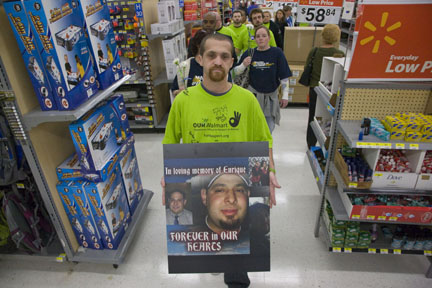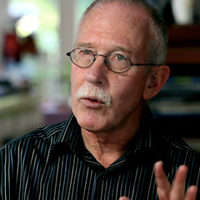
SAN LEANDRO, Calif. – On past Black Fridays, the nation’s annual post-Thanksgiving shopping celebration, Walmart stores have seen such a crush of shoppers that people have been trampled trying to get through the doors. On this coming Black Friday, however, shoppers are more likely to see protesting workers.
People have been criticizing the chain’s low wages and unfair competition with local businesses for years. But for a long time the company has been able to keep its workers from joining in. Where it could, Walmart has tried to give itself a paternalistic, we’re-all-one-big-family face. Where that hasn’t worked, it’s resorted to the age-old tactics of firings and fear.
But Walmart workers are waking up. Supported by a number of unions, they’ve organized a series of work stoppages, the latest and most extensive of which will take place on Black Friday. They call their organization OURWalmart (Organization United for Respect at Walmart).
Strikes at Walmart stores are usually short walkouts by groups of mostly-young people, propelled by pent-up anger at abuse by managers and wages so low no one can really live on them. My heart goes out to these workers. I, too, was fired more than once for trying to organize a union where I worked. I remember how it felt to be an open activist in a plant where the company made no secret of its hatred for what we wanted – a union.
So when I went to take pictures at a walkout at the San Leandro Walmart, I wanted to make visible the faces of people with the courage to defy their boss. And I wanted to see how people who like that union idea, as I do, can help keep the company from firing them. This is what I saw.
We got together in the parking lot of the BART rapid transit station a few blocks from the store. Several dozen supporters joined a handful of workers who’d already been fired, along with a couple of associates (as the workers call themselves) from other Walmarts in the area. Together marched down Hesperian Boulevard, through the parking lot, to the doors.
Once enough people had gathered, both fired and currently employed workers held a brief memorial for Enrique, an associate who’d recently died. Inside the store, they’d set up a small memorial outside the break room. The crowd outside walked solemnly through the doors and down the aisles heading for it, carrying Enrique’s photograph in front.
Raymond Bravo, who works in the Richmond store, and other workers held a banner as they walked past the shelves and shoppers. Misty Tanner later told me she’d been fired after several years at Walmart, most recently as a member of a crew doing renovations at the store in Richmond. What must she have felt, walking through the aisles of Walmart, where she’d been terminated not long before?
These fired workers are very present in the minds of those still working. I remembered my own experience, after I and several friends were terminated and blacklisted at a Silicon Valley semiconductor plant. We tried not to disappear too. It wasn’t just that we didn’t want to feel the company had beaten us. We found it actually reduced the fear among the union supporters who were still working. They could see we didn’t just disappear (what the company undoubtedly wanted). We refused to become a bad dream to frighten people. Everyone knew we’d been fired anyway. Remaining present in people’s lives meant we weren’t a dark secret people feared talking about.
I could see that the Walmart workers, both working and fired, still cared for each other. They too were not about to forget what the company had done, or let anyone else forget either.
At the door to the break room, a worker who’d clocked out, Dominic Ware, stood by as we laid our carnations on the floor in memory of Enrique. Two store managers stood by watching us. Another followed us, yelling in a loud voice that we had no right to be there. He was especially bothered by photographs, and kept putting his hand in front of the camera to stop me from taking them.
It was pretty obvious that they wanted to disrupt what was intended to be a respectful and solemn remembrance for Enrique. Even further, they tried to make absolutely sure that every worker in the store knew exactly how much the company hated what was happening. Dominic stayed calm, an example to his coworkers that no one needed to be frightened.
Supporters and workers together put their flowers on the store floor. I wondered how long it would take for managers to remove them, and all the evidence of this job action.
After we left the store, Dominic spoke at a short rally outside, while the sun set and it grew dark. Nurses from the California Nurses Association, longshore and warehouse workers from the ILWU, machinist union representatives, young community activists and other supporters stood together with the Walmart workers.
Three workers from this store, Dominic Ware, Marsela Lopez-Navarro and Cecilia Gurule, had clocked out and joined the rally. That took courage. Everyone in the store knows the company not only hates unions, but also has fired workers who want to organize.
Once the rally was over, workers were unsure whether the company would let them return to their jobs. So everyone got behind them and marched back to the door, where a manager met them. Dominic, Cecilia and Marsela then read him a statement declaring their right to participate in collective action — the basic activity involved in forming a workers’ association or a union. If the company tried to keep them off the job or retaliated against them, they warned, it would be a violation of Federal labor law.
Then we all walked back into the store, accompanying Dominic and Cecilia to the break room. There the key test was whether they would be able to punch the time clock and go back to work. It’s hard to describe how good it felt to see Dominic come out of the break room in his work vest and go back to his job.
I was never able to go back to work at National Semiconductor, or the other workplaces where I was fired. In our Walmart demonstration there were fired workers who shared that bitter experience. But for this one evening, we were able to help Dominic, Marsela and Cecelia do what should be their right without question – challenge their employer and declare their open support for the right to organize.
No one should have to be afraid that such a basic right of free thought, speech or association might cost them their job. Yet the reality in this country is that it so often does. And at Walmart, the human casualties are very much present.
But for one evening direct action by courageous workers, supported by people living in the community around them, kept firings from happening. That was a big step toward making that right something that exists in real life, not just on paper.
Photo via David Bacon.







